candle lamp
Flashlight Enthusiast
Fenix has updated their PD32 model with a new emitter and a circuit, featuring much higher output and a revised interface. It's PD32 Ultimate Edition (UE).
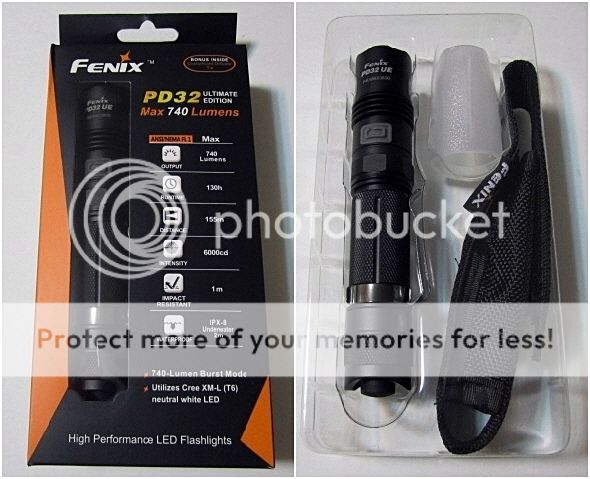
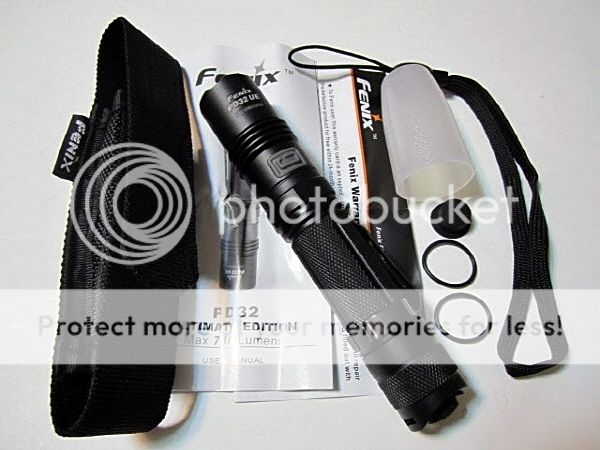
The light comes in basic packaging, and it comes with a user manual, warranty card, diffuser tip (AOD-S), spare o-rings, tailcap rubber switch boot, pocket clip (attached), wrist lanyard, and holster with closing flap.
.
.
Manufacturer Specifications from user manual :
• Cree XM-L (T6) Neutral White LED with lifespan of 50,000 hours
• Uses one 18650 rechargeable Li-ion battery or two 3V CR123A Lithium batteries
• 138mm (Length) x 24mm (Diameter)
• 74-gram weight (excluding the battery)
• Digitally regulated output - maintains constant brightness
• Low-voltage warning function to remind you to replace the battery
• Reverse polarity protection guards against improper battery installation
• Over-heat protection to avoid high-temperature of the surface
• Anti-roll, slip-resistant body design
• Tactical tail switch with momentary-on function
• Side switch in head
• Made of durable aircraft-grade aluminum
• Premium Type III hard-anodized anti-abrasive finish
• Toughened ultra-clear glass lens with anti-reflective coating
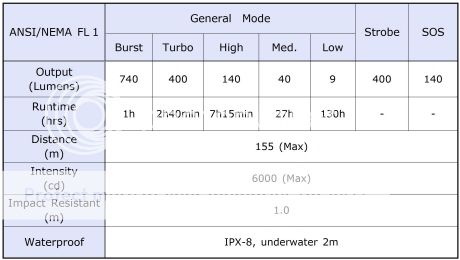
Notice : The above-mentioned parameters (lab-tested by Fenix using ARB-L2 rechargeable Li-ion battery) are approximate and may vary between flashlights, batteries and environments.
* The flashlight will drop down into the Turbo brightness level after working about 3 minutes in the Burst output. Therefore the runtime of Burst output is an accumulated time.
** The flashlight will transfer into the High brightness level after working about 30 minutes in the Turbo output. Therefore the runtime of Turbo output is an accumulated time.
.
.
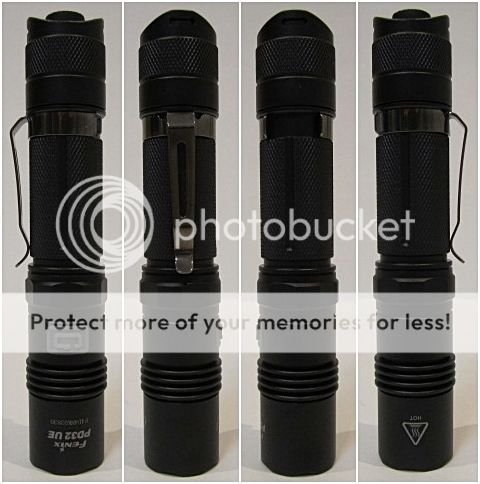
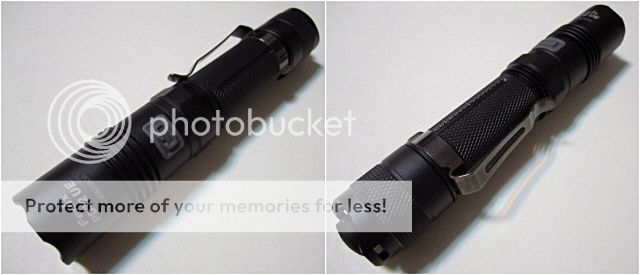
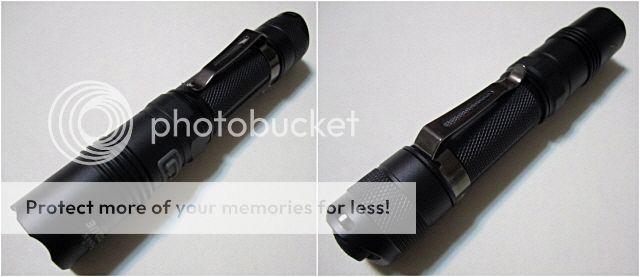
The hard (type III) anodizing is a matt black and consistent throughout with no chips or damage of other faults to be found on my sample. Anodizing is very good on my sample. There are identification labels on the head only. All labels are sharp, clear. Actually labels are not as bright white as some other lights, but that actually helps to make them less obtrusive. The diamond-shape knurling is present over battery tube and tailcap. The clip-on stainless steel clip looks and feels very substantial than typical in this class. It holds onto the light very tightly. The clip works as a good anti-roll device.
.
.
Let's see how the PD32 UE (XM-L T6) compares to the PD32 prototype (XP-G R5) I reviewed in appearance.
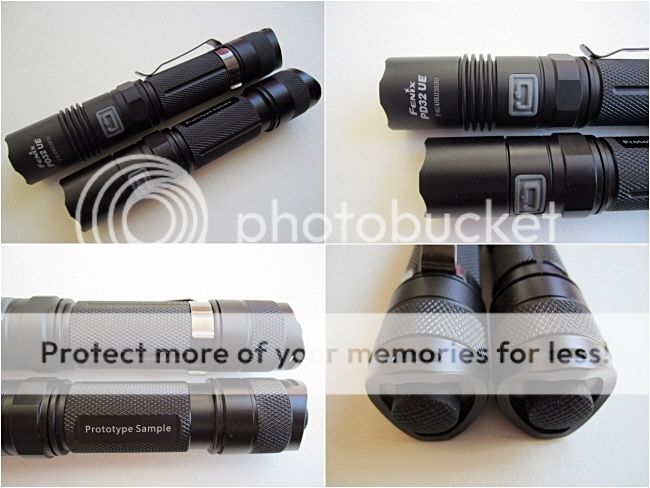
The PD32 UE is a little longer than R5 version due to the extended head length (i.e., the UE has cooling fins in the head, and they add a little extra length). The UE has no flat sides which has logo printed on the battery tube. The tailcap is same as on the R5 version.
.
.
[New 12.12.11]
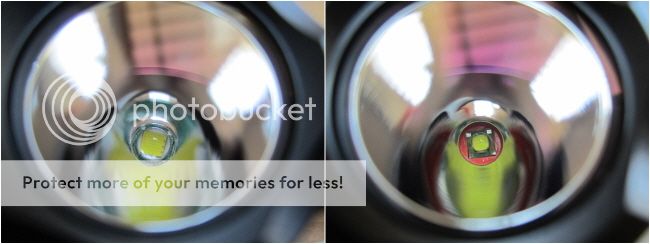
The reflector size seems to be quite same in two lights. The emitters are XM-L T6 (PD32 UE) and XP-G R5 (PD32 Prototype). [New 12.12.11]
.
.
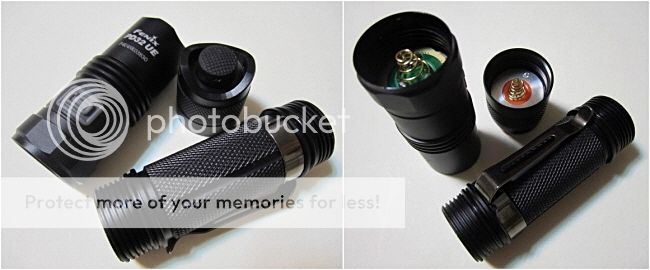
The light has 3 parts (i.e. head, battery tube, and tailcap).
.
.
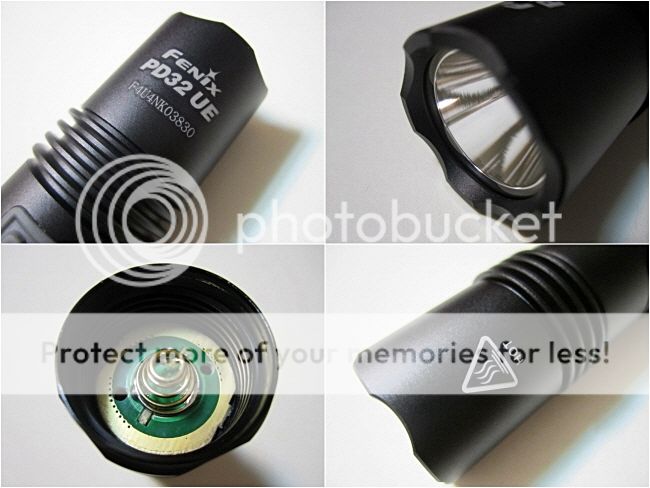
The head has pure cylindrical design with decagonal shape at the neck (i.e., right under the side switch) which provides good grip and anti-roll feature. The head tip has five-point crenellations allowing light to shine through when left placed head down.
There are four deep cooling fins for heat dissipation on the head. There is a spring on the positive contact plate in the head, so flat-top batteries should work fine. The user manual says the light has reverse polarity protection to protect from improper battery installation (i.e., the electronics of the PD32 UE itself has in-built reverse polarity protection.)
.
.
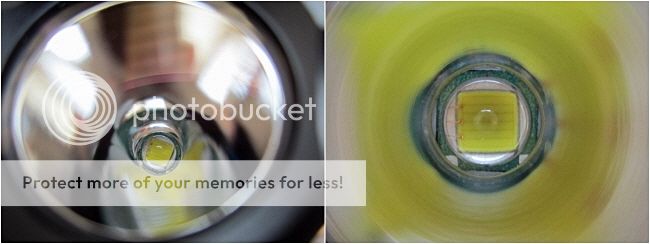
The light uses AR coating lens and the purple hue is reflected on it. The aluminum reflector has a smooth pattern. Surface finish on the reflector was perfect from visual inspection, with very fine radial machining lines running down the reflector cup, and well-centered XM-L T6 neutral tint LED sits at the bottom of the reflector cup.
.
.
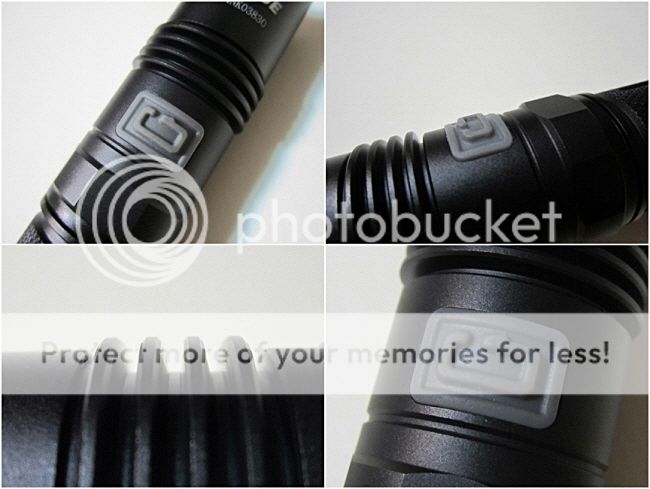
The distinctive aspects of the light is the dual-switch control in the head and tailcap of the light, and the addition of the burst output level. The mode-changing side switch is electronic switch, with a more clear and audible click than R5 version. It has a good amount of tension which produces a less quiet clicking sound when pressed than R5 version.
.
.
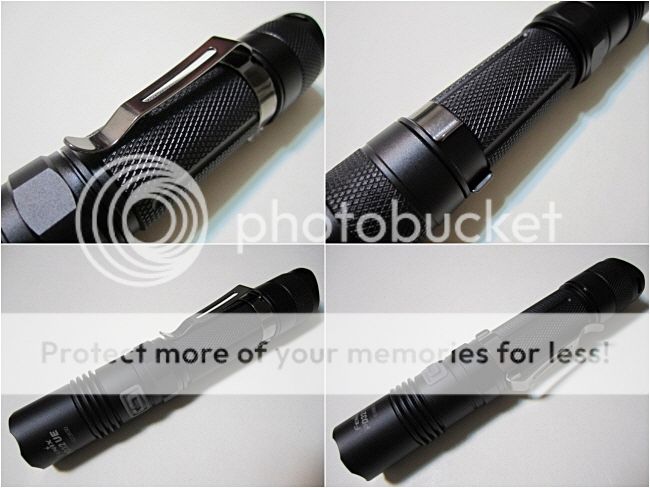
The battery tube has a plain cylindrical tube design and accommodates both 2xCR123A's and (un)protected 18650 cells easily. Note the user manual does mention 3.7V 2xRCR123A's can be used cautiously. I emailed Fenix to confirm this. They did respond that technically the user can use 3.7V two 16340 rechargeable batteries, but Fenix do not suggest because of the higher voltage & the lower efficacy (i.e., the capacity of two 16340's can not sometimes catch up with 18650's capacity). [New 12.12.11] Fenix have confirmed the input voltage range is 2.7V~8.4V. [New 12.12.11]
The entire light's small & clean cylindrical design makes it feel very comfortable when held in hand. The battery tube has a notch on the end where the removable clip can be attached.
The clip is head-facing, and it seems to be a titanium-coated stainless steel. The diameter of the both ends of the battery tube is same, so head and tailcap can be reversed on the battery tube. It means the pocket clip is reversible without removing it from the original position. There is no risk the light might catch on something and be pulled off.
.
.
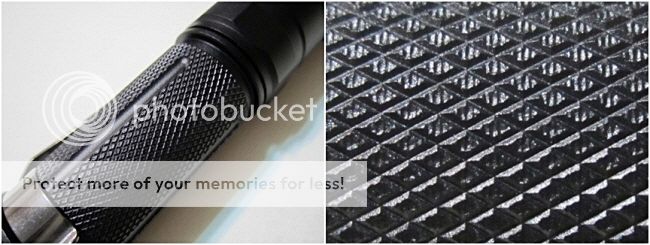
Most of the battery tube is covered by diamond-textured knurling which should provide more than enough grip. Knurling is a bit aggressive.
.
.
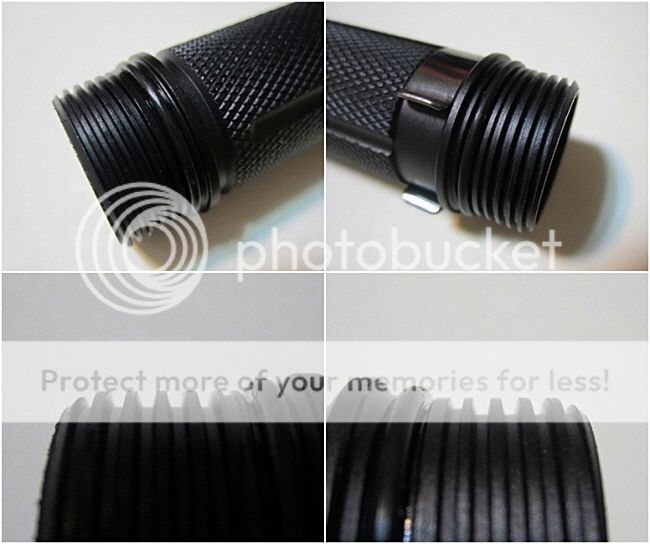
Threads on both ends are well machined as well, with the those on the both end being anodized which allows the light to be locked-out when the tail cap is slightly loosened.
Threads on either ends on the battery tube mate well with the head and tailcap with no issues of cross-threading or grinding. The screws threads are square-cut.
.
.
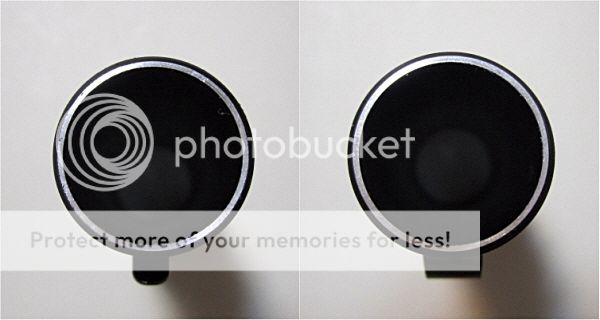
The wall thickness of the battery tube is reasonably thick, and the light feel solid.
.
.
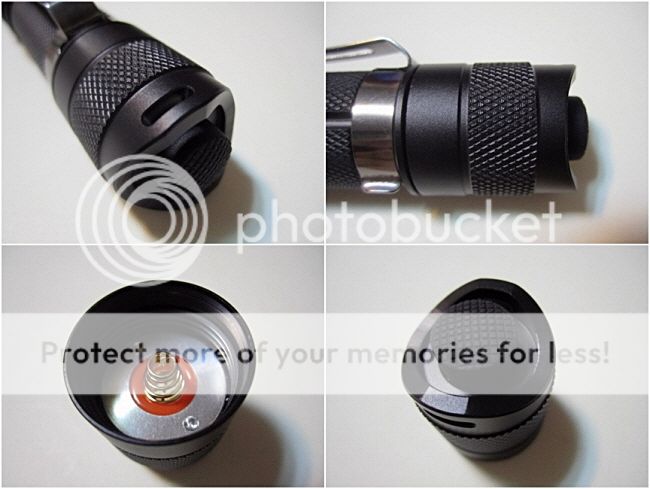
The tailcap switch is a forward clicky which allows for momentary activation. The rubber switch cap protrudes out the tail end (i.e., the light can't tailstand). The switch has nice stiff tension with average travel. There is a band of knurling on the tailcap.
.
.
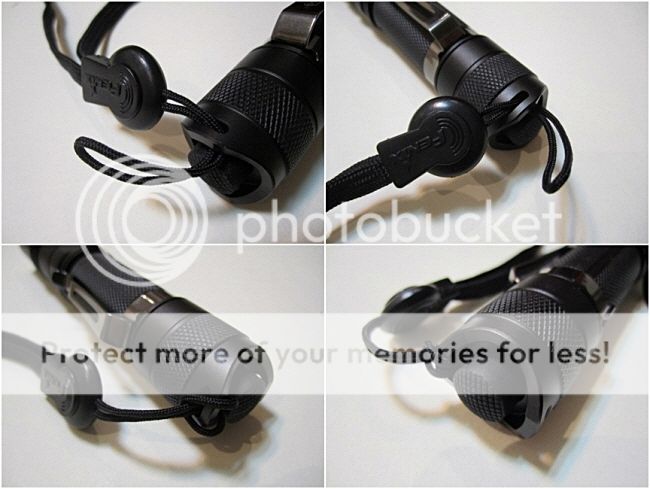
There are a couple of wide loops for wrist lanyard attachments.
.
.
User Interface
The PD32 UE has same interface as the PD32 Prototype R5 with the exception of burst mode.
Turn on-off by the tailcap forward clicky switch (press-on for momentary, click for locked on).
There are two modes (i.e., general mode & flashing mode).
On-off is controlled by the tailcap switch and output mode switching is controlled by the side switch on the head.
1) General mode
Output changing is controlled by the electronic side button switch. Click and release to advance through outputs, which proceed in sequence from Burst -> Low -> Med. -> High -> Turbo, in repeating sequence. The light has mode memory, and remembers the last output level used when you turn the light off and back on, even after a battery change.
Note that you cannot set the output level while the light is off. The electronic switch only works when the light is powered on by the tail switch first. As such, there is no standby current on the PD32 UE.
2) Flashing mode
The "hidden" Strobe, SOS are accessed by clicking and holding the side button switch for one second and three seconds respectively. A single press on the side switch will return to the memorized output level in general mode. The flashing mode has no memory.
.
.
Overheating Protection
After 3 mins of continuous runtime on Burst output, PD32 UE will drop down to Turbo output to avoid overheating the light. If Burst output is needed for extended run time, just turn off and on the light during working on Burst or press the smaller switch once after dropping down to Turbo. But note that the user manual says prolong use of the Burst output may reduce the life span of the light or even cause permanent damage to the light. The light will transfer into High after working about 29 min. in Turbo for over-heat protection. If the non-stop Turbo is needed, just reset it again like as Burst mode.
.
.
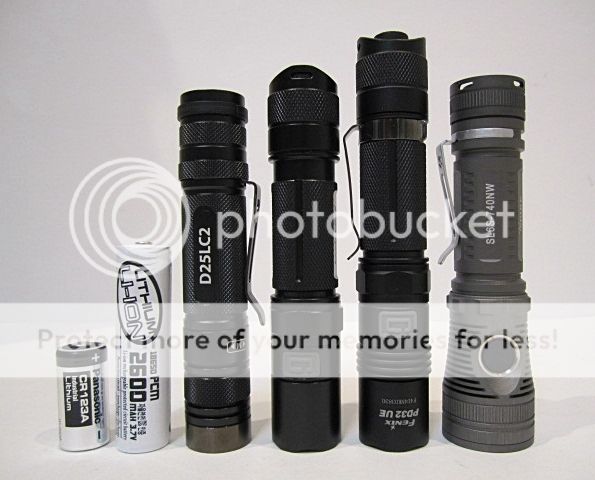
From left to right, Panasonic CR123A, VicLite 18650(2600mAh) protected, Eagletac D25LC2, Fenix PD32 (Prototype, R5), Fenix PD32 UE, Spark SL6S-740NW.
.
.
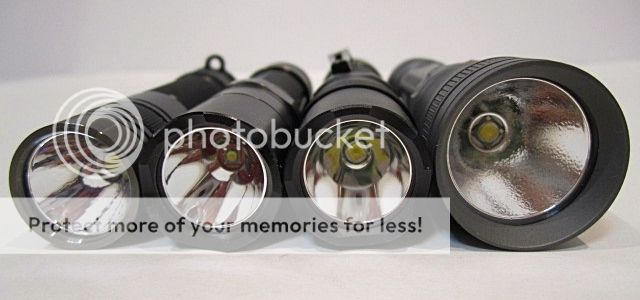
The head size & body weight excluding battery of four lights are as follows :
D25LC2 - 22.5mm / 54g, PD32 R5 - 24.0mm / 61g, PD32 UE - 24.0mm / 77g, SL6S - 31.1mm / 74g
.
.
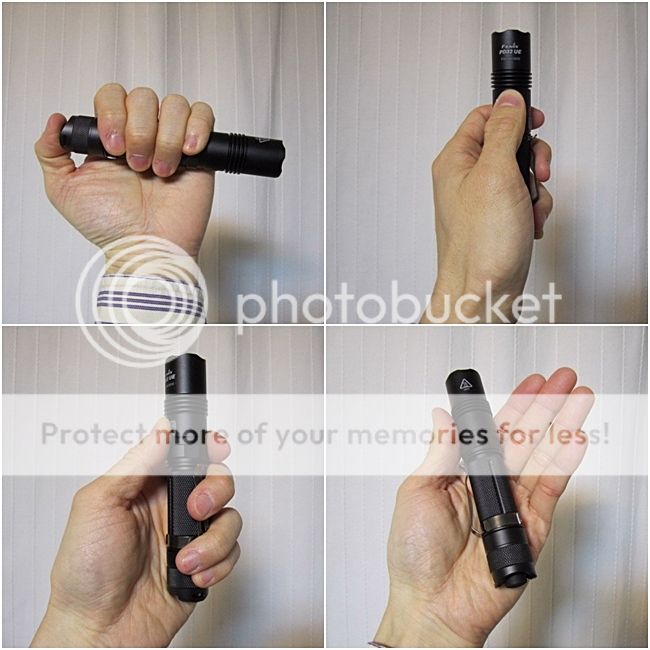
It is good size to hold and can be used as an EDC light. Overall grip is fine.
.
.
Measured Dimensions & Weight
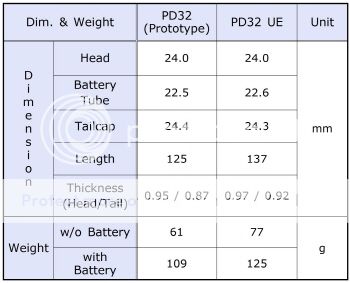
.
.
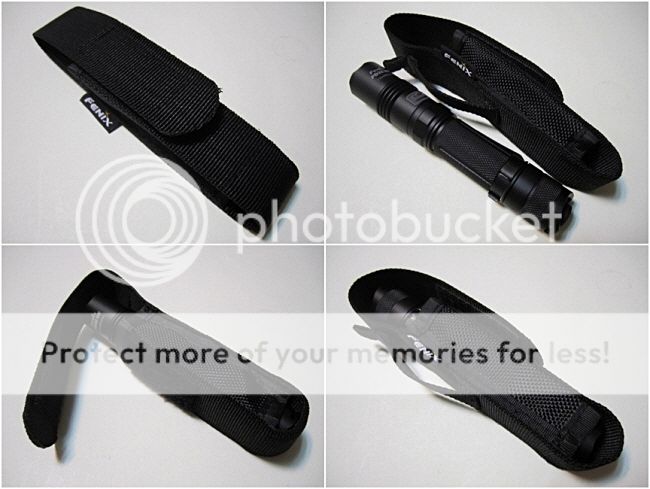
PD32 UE comes with a basic nylon holster with a velcro strap on the head. The light fits in the holster either head-up or head-down.
.
.
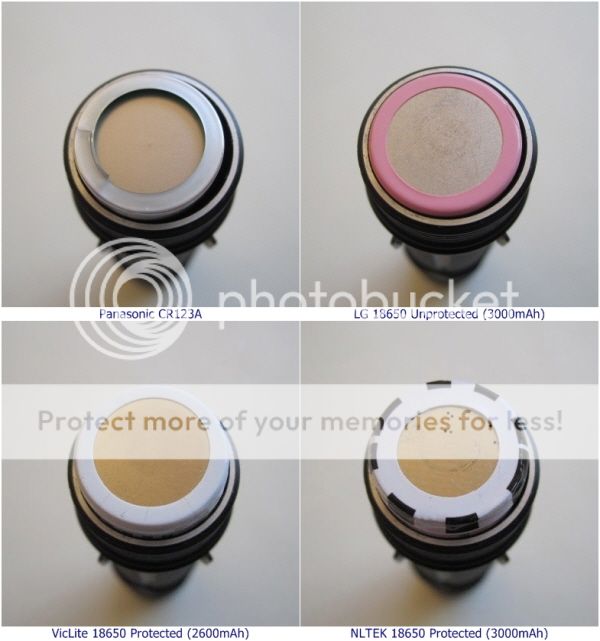
The CR123A & 18650 fit well in the tube. All types (i.e., true flat-tops, wide and small button-tops) of 18650's work fine. Overall build quality is excellent.
.
.
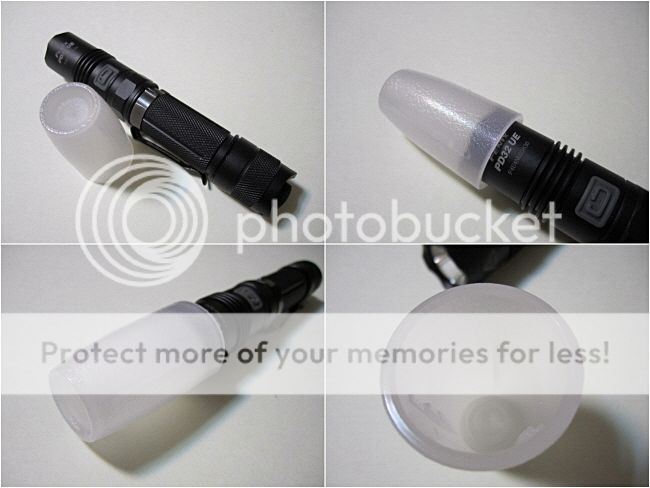
The AOD-S diffuser comes with the light is good, and soften output of the light.
.
.
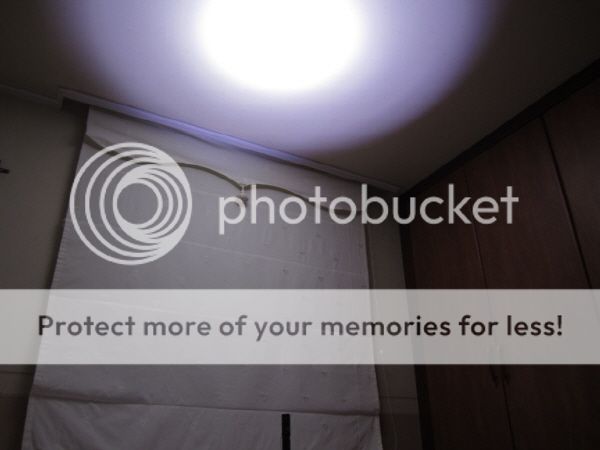
- Without diffuser
.
.

- With diffuser
.
.
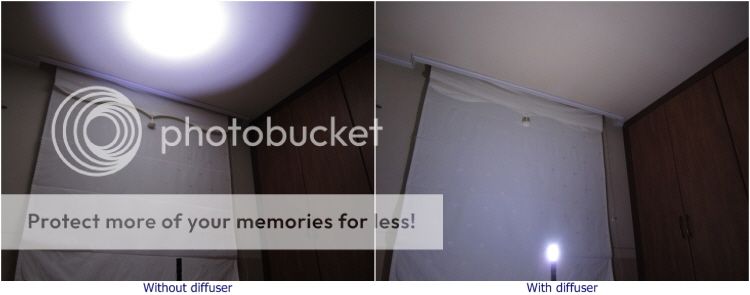
The diffuser gives a nice even beam, and dose the intended job well.
.
.
PWM
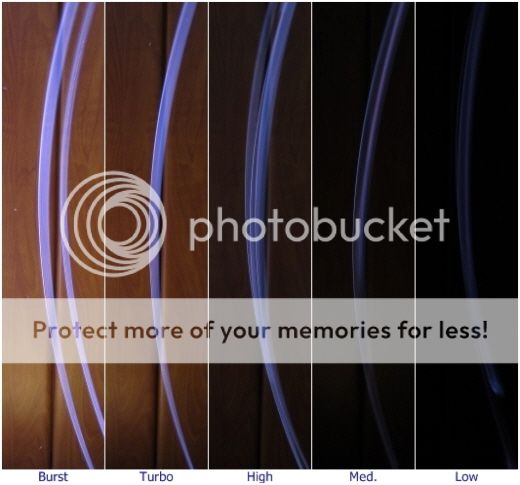
No sign of PWM at any level of the light, leading me to conclude the light is actually current-controlled as claimed. I notice there is neither buzzing sound nor tint-shift at all output levels with the naked eye on my sample.
.
.
Runtime
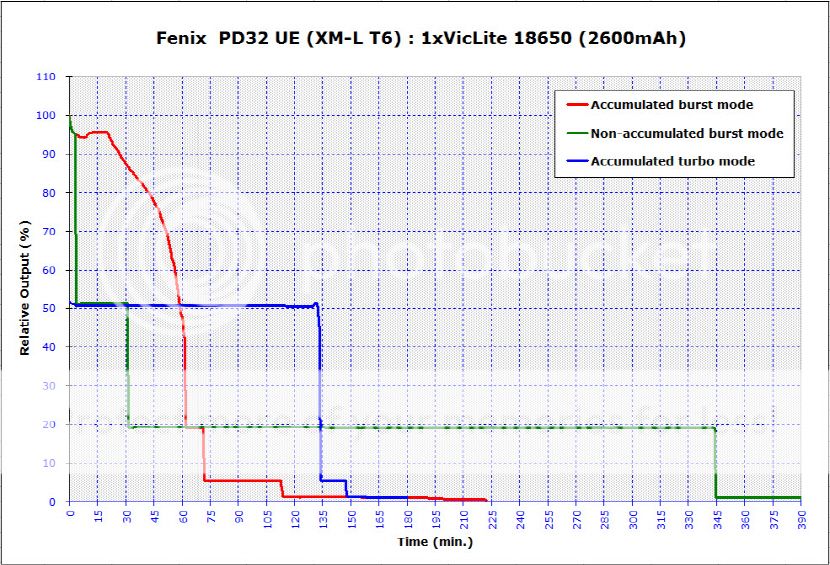
The above runtime labelled as "Accumulated burst (or Turbo) mode" is an accumulated runtime for burst (or Turbo) output. Regulation is maintained very nicely through Burst and Turbo mode on 1x18650 battery.
The PD32 UE steps down on Burst to Turbo after 3 mins runtime, and does step down on Turbo to High after 29 mins runtime as well for over-heat protection. This seems to be a timed drop-down considering the battery depletion, not a thermal sensor feature to avoid overheating the light. As with the other Fenix lights, the regulation pattern and runtime efficiency of the current controlled circuit seems excellent.
The runtime for 10% output of accumulated Burst is appr. 72 mins in my test. (The runtime for non-accumulated Burst is 344 mins.)
The runtime for 10% output of accumulated Turbo is appr. 148 mins in my test.
There are four distinct step-downs (i.e., Burst to Turbo, Turbo to High, High to Med., Med. to Low) at the stage of battery depletion. I could see there was three times flashing or blinking every 5 minutes to indicate low voltage on low output level.
.
.
Beamshot
[New 12.12.11]
1. White door beamshot (about 50cm from the white door)
- ISO100, F/3.5, 1/200sec, Auto white balance
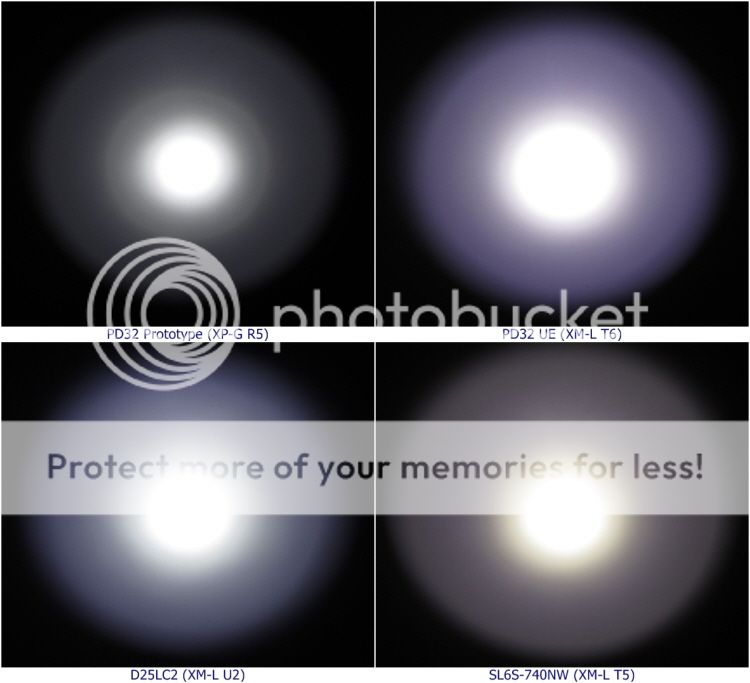
.
.
- ISO100, F/3.5, 1/400sec, Auto white balance
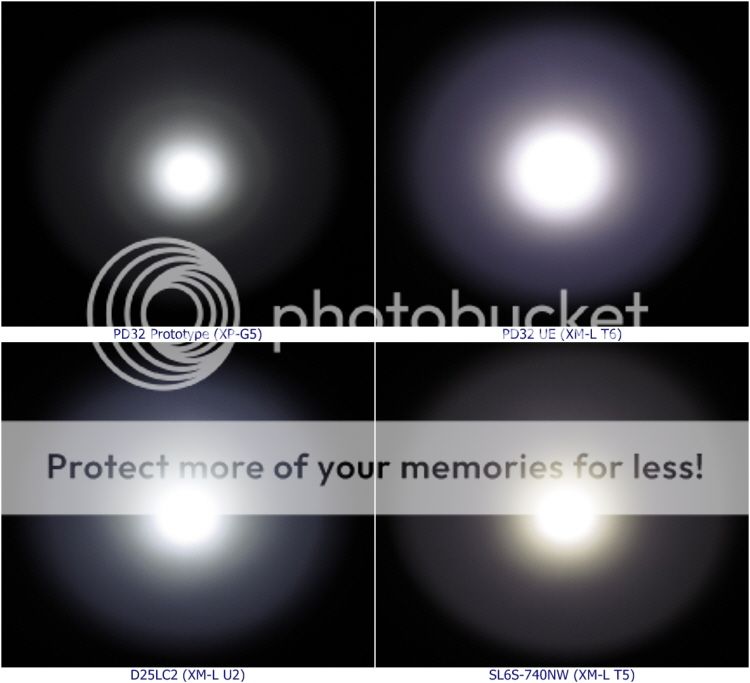
.
.
- ISO100, F/3.5, 1/1000sec, Auto white balance
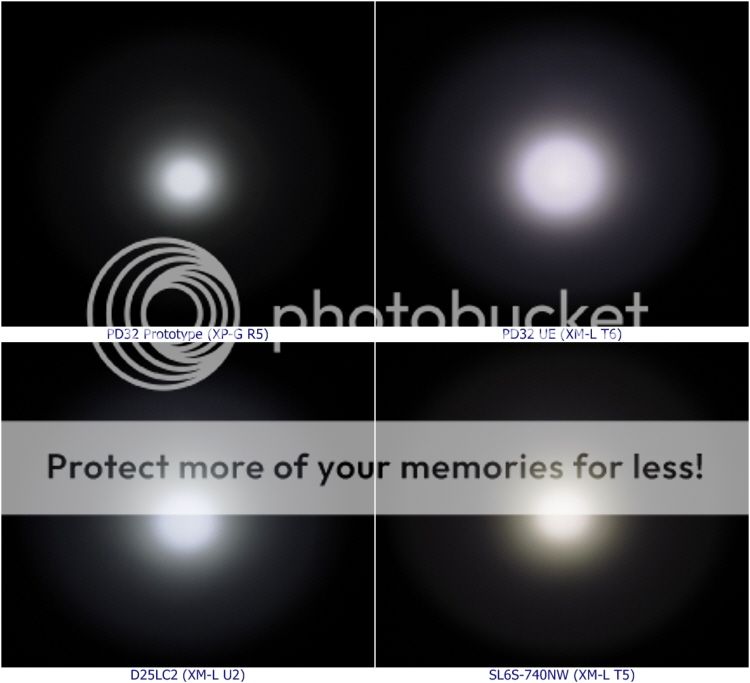
.
.
- ISO100, F/3.5, 1/1250sec, Auto white balance
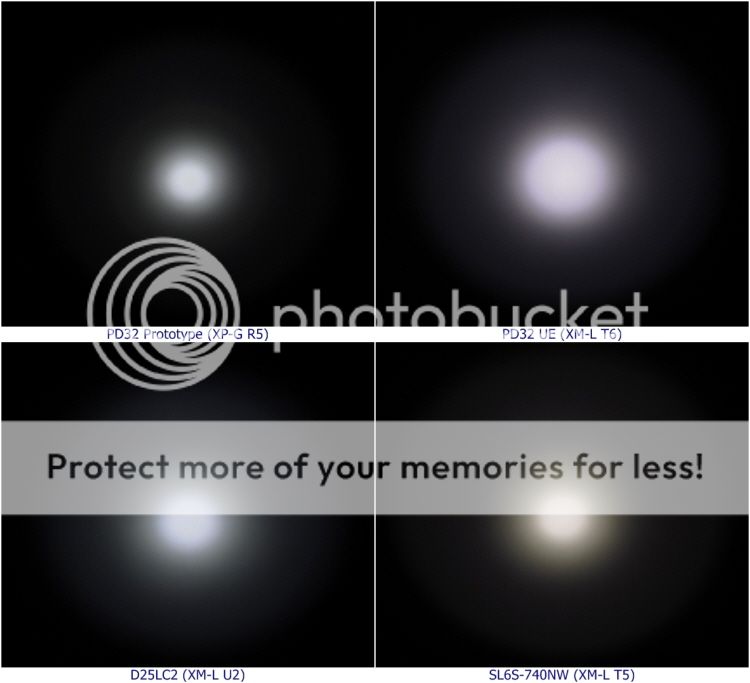
The light has a larger sized bright hot spot than others and it is well focused. There is a soft corona surrounds the hotspot. The edge region of the spill beam has some artifacts due to the five-point crenellations on the head tip. The hot spot and corona region show an warmer tint and the spill beam region shows a bit bluish tint (but not noticeable in normal use). The beam seems to be a slightly cool side in my eyes. [New 12.12.11]
.
.
[New 12.12.12]
2. Indoor beamshot (about 7m from the target)
- ISO100, F/2.8, 1/3sec, Auto white balance

- Control Shot
.
.

- PD32 Prototype (XP-G R5)
.
.
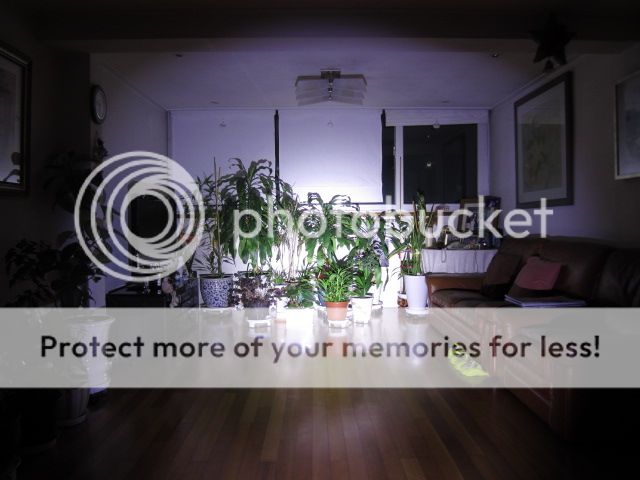
- PD32 UE (XM-L T6)
.
.
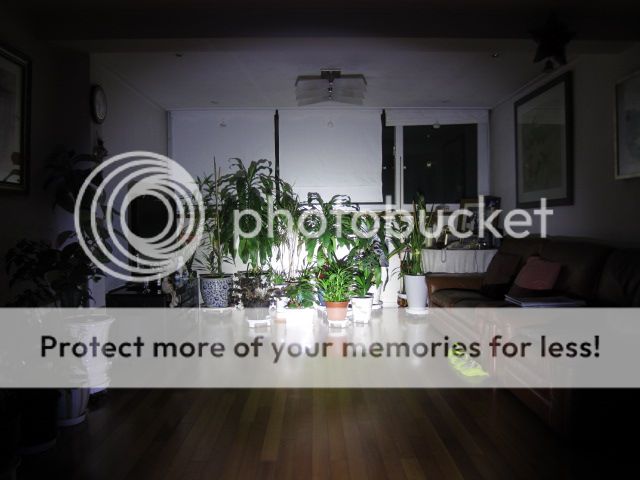
- D25LC2 (XM-L U2)
.
.
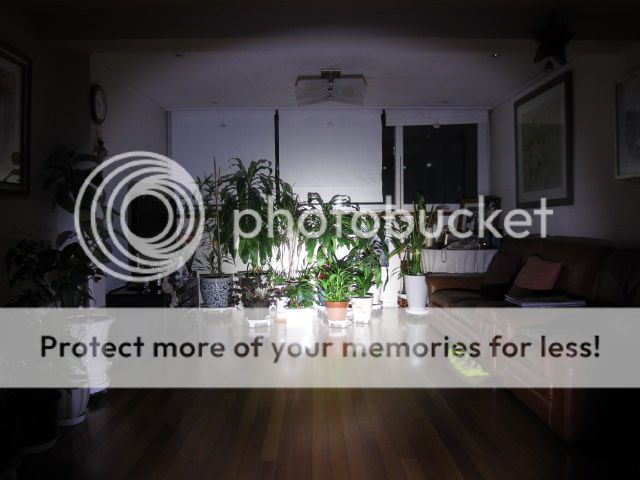
- SL6S-740NW (XM-L T5)
.
.
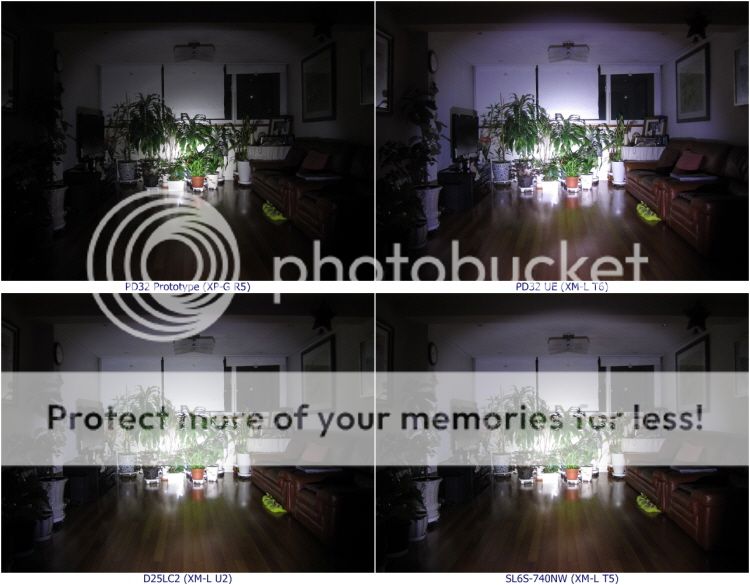
[New 12.12.12]
.
.
[New 12.12.13]
3. 55m Outdoor Beamshot
- ISO100, F/2.8, 1sec, Auto white balance

- Control Shot
.
.
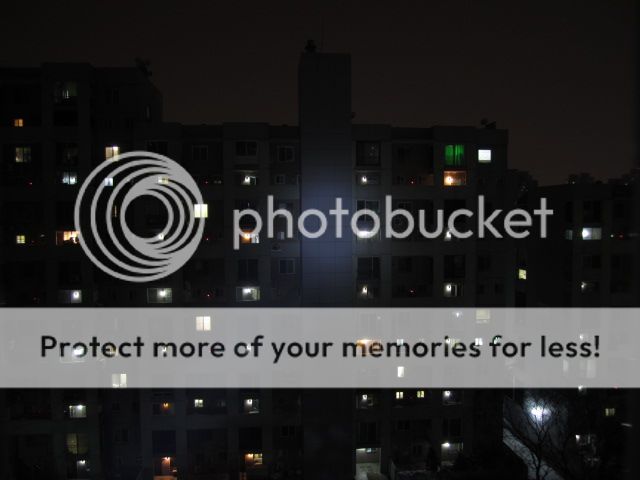
- PD32 Prototype (XP-G R5)
.
.
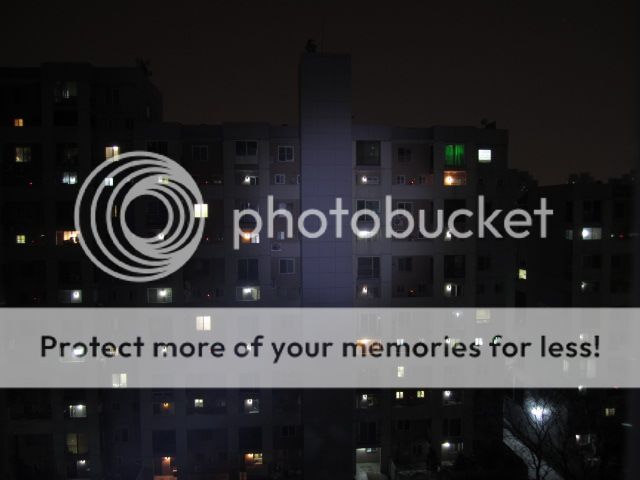
- PD32 UE (XM-L T6)
.
.
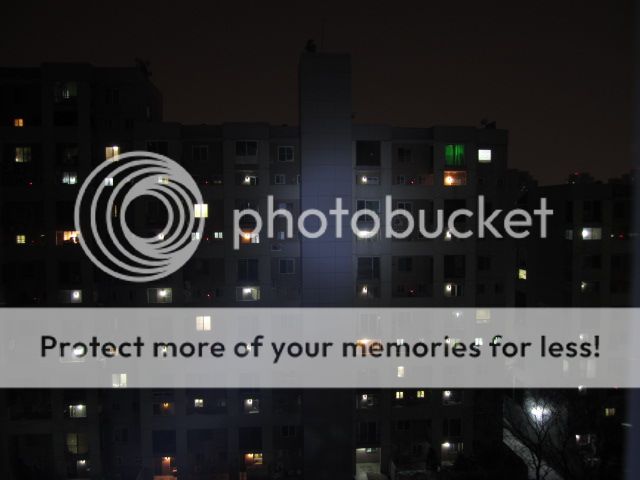
- D25LC2 (XM-L U2)
.
.
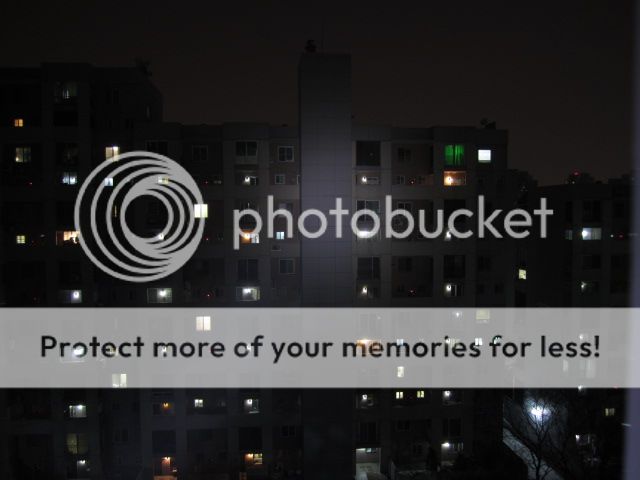
- SL6S-740NW (XM-L T5)
.
.
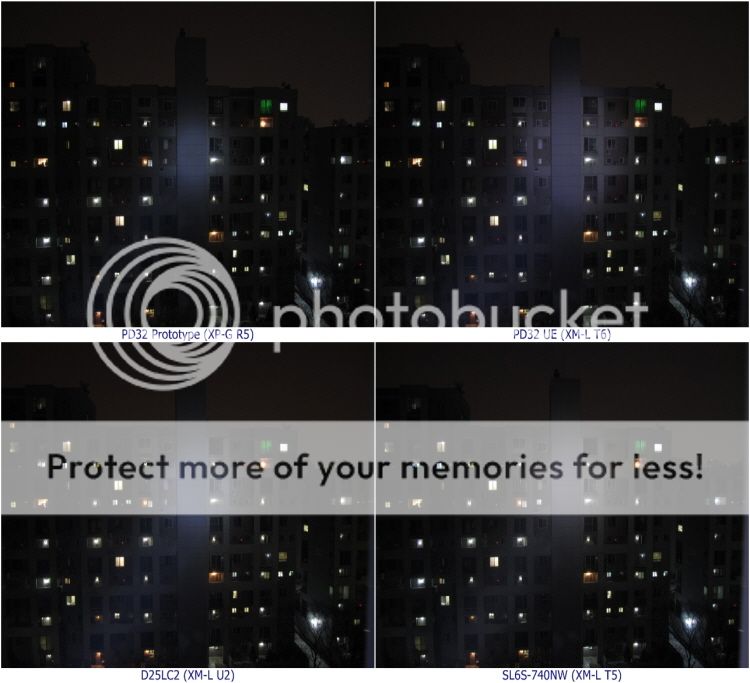
.
.
4. 60~65m Outdoor Beamshot
- ISO100, F/2.8, 1sec, Auto white balance
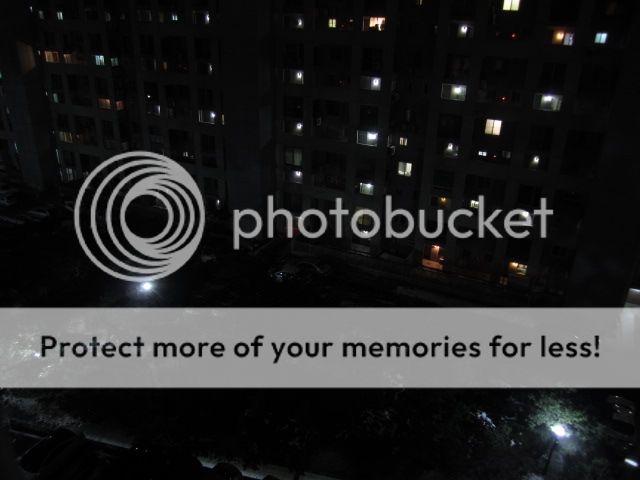
- Control Shot
.
.

- PD32 Prototype (XP-G R5)
.
.
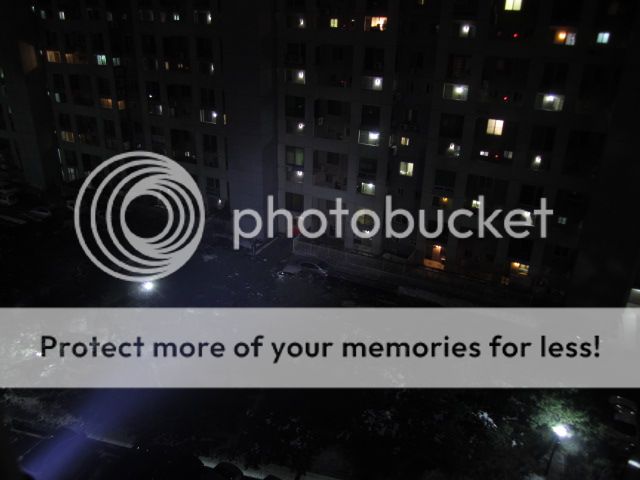
- PD32 UE (XM-L T6)
.
.
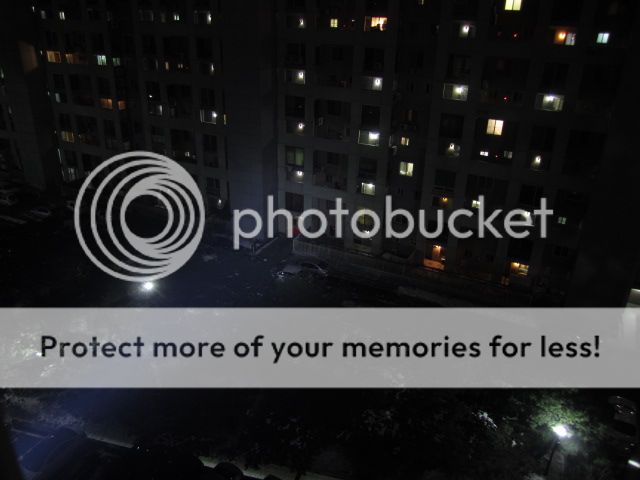
- D25LC2 (XM-L U2)
.
.
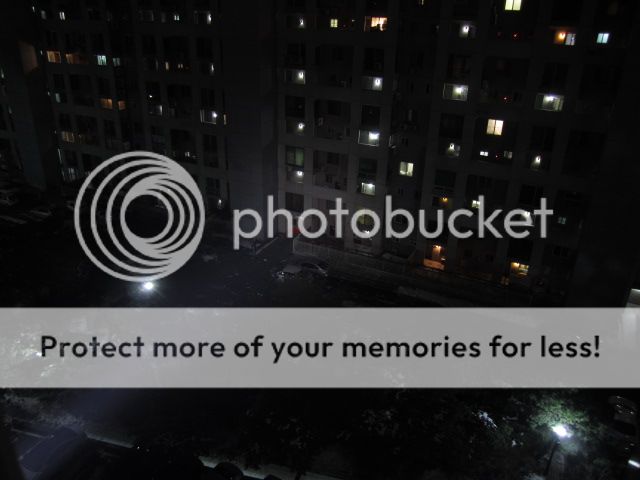
- SL6S-740NW (XM-L T5)
.
.
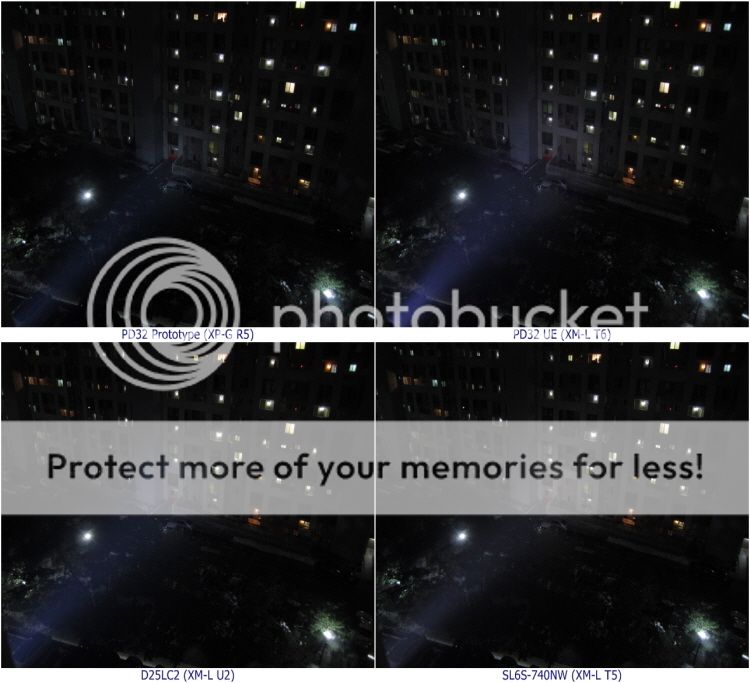
[New 12.12.13]
.
.
Thanks for watching!


The light comes in basic packaging, and it comes with a user manual, warranty card, diffuser tip (AOD-S), spare o-rings, tailcap rubber switch boot, pocket clip (attached), wrist lanyard, and holster with closing flap.
.
.
Manufacturer Specifications from user manual :
• Cree XM-L (T6) Neutral White LED with lifespan of 50,000 hours
• Uses one 18650 rechargeable Li-ion battery or two 3V CR123A Lithium batteries
• 138mm (Length) x 24mm (Diameter)
• 74-gram weight (excluding the battery)
• Digitally regulated output - maintains constant brightness
• Low-voltage warning function to remind you to replace the battery
• Reverse polarity protection guards against improper battery installation
• Over-heat protection to avoid high-temperature of the surface
• Anti-roll, slip-resistant body design
• Tactical tail switch with momentary-on function
• Side switch in head
• Made of durable aircraft-grade aluminum
• Premium Type III hard-anodized anti-abrasive finish
• Toughened ultra-clear glass lens with anti-reflective coating

Notice : The above-mentioned parameters (lab-tested by Fenix using ARB-L2 rechargeable Li-ion battery) are approximate and may vary between flashlights, batteries and environments.
* The flashlight will drop down into the Turbo brightness level after working about 3 minutes in the Burst output. Therefore the runtime of Burst output is an accumulated time.
** The flashlight will transfer into the High brightness level after working about 30 minutes in the Turbo output. Therefore the runtime of Turbo output is an accumulated time.
.
.



The hard (type III) anodizing is a matt black and consistent throughout with no chips or damage of other faults to be found on my sample. Anodizing is very good on my sample. There are identification labels on the head only. All labels are sharp, clear. Actually labels are not as bright white as some other lights, but that actually helps to make them less obtrusive. The diamond-shape knurling is present over battery tube and tailcap. The clip-on stainless steel clip looks and feels very substantial than typical in this class. It holds onto the light very tightly. The clip works as a good anti-roll device.
.
.
Let's see how the PD32 UE (XM-L T6) compares to the PD32 prototype (XP-G R5) I reviewed in appearance.

The PD32 UE is a little longer than R5 version due to the extended head length (i.e., the UE has cooling fins in the head, and they add a little extra length). The UE has no flat sides which has logo printed on the battery tube. The tailcap is same as on the R5 version.
.
.
[New 12.12.11]

The reflector size seems to be quite same in two lights. The emitters are XM-L T6 (PD32 UE) and XP-G R5 (PD32 Prototype). [New 12.12.11]
.
.

The light has 3 parts (i.e. head, battery tube, and tailcap).
.
.

The head has pure cylindrical design with decagonal shape at the neck (i.e., right under the side switch) which provides good grip and anti-roll feature. The head tip has five-point crenellations allowing light to shine through when left placed head down.
There are four deep cooling fins for heat dissipation on the head. There is a spring on the positive contact plate in the head, so flat-top batteries should work fine. The user manual says the light has reverse polarity protection to protect from improper battery installation (i.e., the electronics of the PD32 UE itself has in-built reverse polarity protection.)
.
.

The light uses AR coating lens and the purple hue is reflected on it. The aluminum reflector has a smooth pattern. Surface finish on the reflector was perfect from visual inspection, with very fine radial machining lines running down the reflector cup, and well-centered XM-L T6 neutral tint LED sits at the bottom of the reflector cup.
.
.

The distinctive aspects of the light is the dual-switch control in the head and tailcap of the light, and the addition of the burst output level. The mode-changing side switch is electronic switch, with a more clear and audible click than R5 version. It has a good amount of tension which produces a less quiet clicking sound when pressed than R5 version.
.
.

The battery tube has a plain cylindrical tube design and accommodates both 2xCR123A's and (un)protected 18650 cells easily. Note the user manual does mention 3.7V 2xRCR123A's can be used cautiously. I emailed Fenix to confirm this. They did respond that technically the user can use 3.7V two 16340 rechargeable batteries, but Fenix do not suggest because of the higher voltage & the lower efficacy (i.e., the capacity of two 16340's can not sometimes catch up with 18650's capacity). [New 12.12.11] Fenix have confirmed the input voltage range is 2.7V~8.4V. [New 12.12.11]
The entire light's small & clean cylindrical design makes it feel very comfortable when held in hand. The battery tube has a notch on the end where the removable clip can be attached.
The clip is head-facing, and it seems to be a titanium-coated stainless steel. The diameter of the both ends of the battery tube is same, so head and tailcap can be reversed on the battery tube. It means the pocket clip is reversible without removing it from the original position. There is no risk the light might catch on something and be pulled off.
.
.

Most of the battery tube is covered by diamond-textured knurling which should provide more than enough grip. Knurling is a bit aggressive.
.
.

Threads on both ends are well machined as well, with the those on the both end being anodized which allows the light to be locked-out when the tail cap is slightly loosened.
Threads on either ends on the battery tube mate well with the head and tailcap with no issues of cross-threading or grinding. The screws threads are square-cut.
.
.

The wall thickness of the battery tube is reasonably thick, and the light feel solid.
.
.

The tailcap switch is a forward clicky which allows for momentary activation. The rubber switch cap protrudes out the tail end (i.e., the light can't tailstand). The switch has nice stiff tension with average travel. There is a band of knurling on the tailcap.
.
.

There are a couple of wide loops for wrist lanyard attachments.
.
.
User Interface
The PD32 UE has same interface as the PD32 Prototype R5 with the exception of burst mode.
Turn on-off by the tailcap forward clicky switch (press-on for momentary, click for locked on).
There are two modes (i.e., general mode & flashing mode).
On-off is controlled by the tailcap switch and output mode switching is controlled by the side switch on the head.
1) General mode
Output changing is controlled by the electronic side button switch. Click and release to advance through outputs, which proceed in sequence from Burst -> Low -> Med. -> High -> Turbo, in repeating sequence. The light has mode memory, and remembers the last output level used when you turn the light off and back on, even after a battery change.
Note that you cannot set the output level while the light is off. The electronic switch only works when the light is powered on by the tail switch first. As such, there is no standby current on the PD32 UE.
2) Flashing mode
The "hidden" Strobe, SOS are accessed by clicking and holding the side button switch for one second and three seconds respectively. A single press on the side switch will return to the memorized output level in general mode. The flashing mode has no memory.
.
.
Overheating Protection
After 3 mins of continuous runtime on Burst output, PD32 UE will drop down to Turbo output to avoid overheating the light. If Burst output is needed for extended run time, just turn off and on the light during working on Burst or press the smaller switch once after dropping down to Turbo. But note that the user manual says prolong use of the Burst output may reduce the life span of the light or even cause permanent damage to the light. The light will transfer into High after working about 29 min. in Turbo for over-heat protection. If the non-stop Turbo is needed, just reset it again like as Burst mode.
.
.

From left to right, Panasonic CR123A, VicLite 18650(2600mAh) protected, Eagletac D25LC2, Fenix PD32 (Prototype, R5), Fenix PD32 UE, Spark SL6S-740NW.
.
.

The head size & body weight excluding battery of four lights are as follows :
D25LC2 - 22.5mm / 54g, PD32 R5 - 24.0mm / 61g, PD32 UE - 24.0mm / 77g, SL6S - 31.1mm / 74g
.
.

It is good size to hold and can be used as an EDC light. Overall grip is fine.
.
.
Measured Dimensions & Weight

.
.

PD32 UE comes with a basic nylon holster with a velcro strap on the head. The light fits in the holster either head-up or head-down.
.
.

The CR123A & 18650 fit well in the tube. All types (i.e., true flat-tops, wide and small button-tops) of 18650's work fine. Overall build quality is excellent.
.
.

The AOD-S diffuser comes with the light is good, and soften output of the light.
.
.

- Without diffuser
.
.

- With diffuser
.
.

The diffuser gives a nice even beam, and dose the intended job well.
.
.
PWM

No sign of PWM at any level of the light, leading me to conclude the light is actually current-controlled as claimed. I notice there is neither buzzing sound nor tint-shift at all output levels with the naked eye on my sample.
.
.
Runtime

The above runtime labelled as "Accumulated burst (or Turbo) mode" is an accumulated runtime for burst (or Turbo) output. Regulation is maintained very nicely through Burst and Turbo mode on 1x18650 battery.
The PD32 UE steps down on Burst to Turbo after 3 mins runtime, and does step down on Turbo to High after 29 mins runtime as well for over-heat protection. This seems to be a timed drop-down considering the battery depletion, not a thermal sensor feature to avoid overheating the light. As with the other Fenix lights, the regulation pattern and runtime efficiency of the current controlled circuit seems excellent.
The runtime for 10% output of accumulated Burst is appr. 72 mins in my test. (The runtime for non-accumulated Burst is 344 mins.)
The runtime for 10% output of accumulated Turbo is appr. 148 mins in my test.
There are four distinct step-downs (i.e., Burst to Turbo, Turbo to High, High to Med., Med. to Low) at the stage of battery depletion. I could see there was three times flashing or blinking every 5 minutes to indicate low voltage on low output level.
.
.
Beamshot
[New 12.12.11]
1. White door beamshot (about 50cm from the white door)
- ISO100, F/3.5, 1/200sec, Auto white balance

.
.
- ISO100, F/3.5, 1/400sec, Auto white balance

.
.
- ISO100, F/3.5, 1/1000sec, Auto white balance

.
.
- ISO100, F/3.5, 1/1250sec, Auto white balance

The light has a larger sized bright hot spot than others and it is well focused. There is a soft corona surrounds the hotspot. The edge region of the spill beam has some artifacts due to the five-point crenellations on the head tip. The hot spot and corona region show an warmer tint and the spill beam region shows a bit bluish tint (but not noticeable in normal use). The beam seems to be a slightly cool side in my eyes. [New 12.12.11]
.
.
[New 12.12.12]
2. Indoor beamshot (about 7m from the target)
- ISO100, F/2.8, 1/3sec, Auto white balance

- Control Shot
.
.

- PD32 Prototype (XP-G R5)
.
.

- PD32 UE (XM-L T6)
.
.

- D25LC2 (XM-L U2)
.
.

- SL6S-740NW (XM-L T5)
.
.

[New 12.12.12]
.
.
[New 12.12.13]
3. 55m Outdoor Beamshot
- ISO100, F/2.8, 1sec, Auto white balance

- Control Shot
.
.

- PD32 Prototype (XP-G R5)
.
.

- PD32 UE (XM-L T6)
.
.

- D25LC2 (XM-L U2)
.
.

- SL6S-740NW (XM-L T5)
.
.

.
.
4. 60~65m Outdoor Beamshot
- ISO100, F/2.8, 1sec, Auto white balance

- Control Shot
.
.

- PD32 Prototype (XP-G R5)
.
.

- PD32 UE (XM-L T6)
.
.

- D25LC2 (XM-L U2)
.
.

- SL6S-740NW (XM-L T5)
.
.

[New 12.12.13]
.
.
Thanks for watching!
Last edited:

